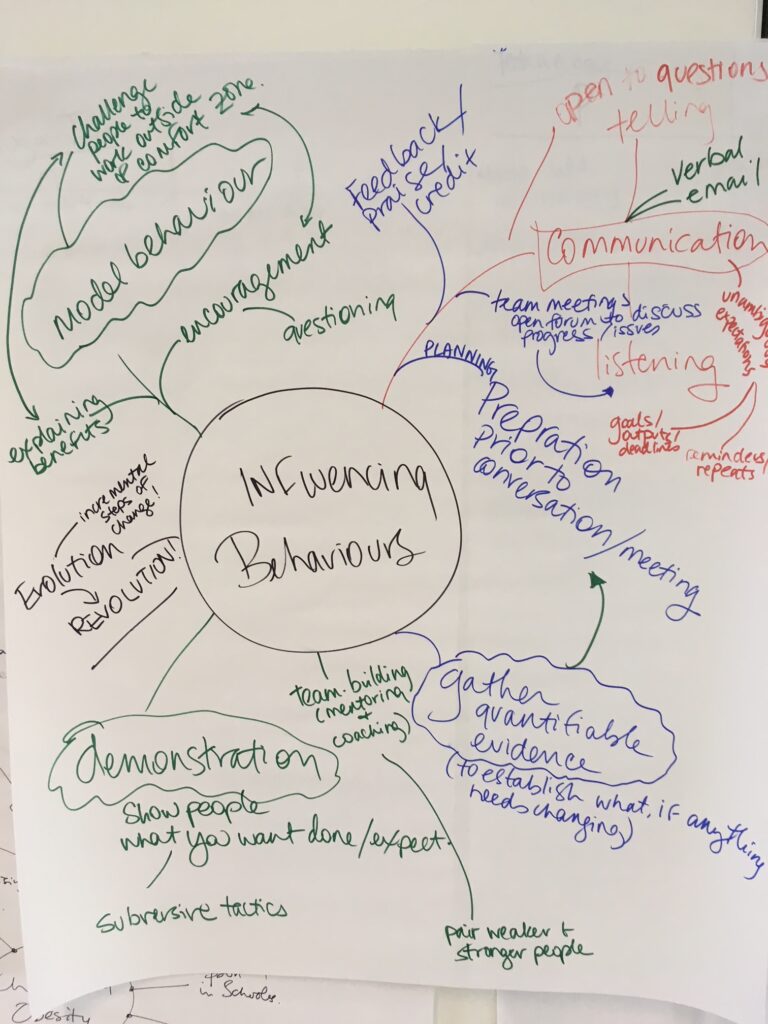“Facilitation is the midwife of ideas”
– Anon
Peter and I have facilitated many workshops, meetings and events over the years. Both of us have also participated in many events. When done well, the process of facilitation involves and respects each individual’s input, fosters a sense of ownership, and helps unleash the collective potential of the group and its members. When workshops are run badly, the opposite is often the outcome
When your team or organisation is going through change, trying to identify new ideas and opportunities, or aiming to develop a more strategic focus, empowering and assisting your staff and stakeholders should be an essential part of the process. It has become ever more important to enable active participation – where people willingly contribute their creativity and energy and take ownership of decisions that affect them.
So, what do you need to do to effectively facilitate a workshop, meeting or event?
The 7 skills described below come from our own personal practice and experience and also other sources including Roffey Park Institute
- Try to remain Impartial/Independent
- Understand Group Dynamics – Difference Exists
- Create Context and Connection
- Develop your style
- Intervene when appropriate
- Use a Tool Based Approach
- Manage Time Successfully
1. Try to remain Impartial/Independent
When facilitating it can be difficult to remain impartial and independent, and not have a pre-determined outcome that you want the group to reach. That’s not facilitation, that’s manipulation.
The challenge therefore is to influence the group but not dominate it. Remember, it’s about them, not you. This means being able to suppress your ideas/solutions and encourage others to talk. This is harder than it sounds. A facilitator needs to encourage the group to consider ideas but their role should be one of guiding and not dictating. Try to help the group reach a consensus or decide on a course of action. The more the group genuinely feels as though it has achieved the outcome for itself, the more it will own it.
2. Understand Group Dynamics – Difference Exists
Pay attention to what is happening in the room. This sits below the content and relates to how people feel about taking part. This is key to unlocking a group’s potential to achieve its goal because it is where you get into the politics and interaction between group members.
Use your senses, your intuition and your instincts to pick up the atmosphere. Are people enthusiastic? Are people expressing their feelings or keeping quiet? Who’s talking and who isn’t? Use questions to challenge and clarify but remember to actively listen to the responses. It is also critical to concentrate on the emotional temperature and try to read the body language and any other non-verbal behaviour.
3. Create Context and Connection
It is very tempting to launch into a session without sufficient context and connection. It satisfies the urge to get going, to get into action and save time.
However, setting good context will enable the audience to relate to what is about to happen. It helps them create their own frame and expectations. If you fail to set a sufficient context, the audience may struggle to connect with what you are about to present.
There will be many opportunities during an event to create context so that the audience knows what is about to happen, how it fits into the overall situation/system/pattern and how it connects with what has gone before and what is due to take place.
For example,
This morning we focused on understanding the situation facing the organisation, its history, what is working and what is not. This afternoon, we want to look at where we want to go, what kind of future we want to achieve for the organisation and for all of us. (Connecting) This is important because without a clear vision of where we are going it will be harder to make the right decisions this year. But it does involve a different kind of thinking to step away from the here and now and imagine what kind of outcomes we would want to see (Creating Context).
Look at the schedule or agenda for your event and mark where it would be important to create context and connection.
4. Develop your personal style
A facilitator’s role is as much about ‘being’ – the energy and personality you bring – as about ‘doing’ – the techniques you use to help the group.
Who you are – your style and presence – impacts your facilitation skills. Where and how you stand and sit, whether you look in control or are flustered, how animated you are – all show your sense of presence as does your tone of voice.
To create an open and honest environment, you need an appreciative, empathic personal presence and the group needs to respect and trust you. They also need to feel confident that you are able to deal with any incidents that may happen. As a facilitator you need to develop your ability to be flexible and resilient in times of challenge and stress.
5. Intervene when appropriate
It’s important to continuously notice what’s going on, make sense of it and then decide what to do about it. You may choose to keep quiet and watch what happens or you could intervene. A look, smile or nod can be all that is needed to intervene, or indicate support, or challenge what is going on.
Challenging the group can be tricky to handle. You may need to ask difficult questions, or which draw attention to difficult process issues which the group may find uncomfortable.
If it is a difficult situation, suggest having a break for coffee or a change of scenery. Perhaps you need to break the group up into pairs, 3’s or 4’s (divide and conquer). If it’s a disruptive individual you may choose to confront that person, perhaps in private, and give them feedback on what they are doing and the impact it is having on the group.
Dealing with conflict is one of the biggest challenges to effective facilitation. Often there can be underlying conflict which is difficult to understand and tackle during the event. There are tactics and skills that you can develop in response to these situations but good preparation is fundamental to understanding where conflict could arise.
6. Use a Tool Based Approach
It will often be necessary to use a tool, a method or process to enhance the session’s activity and experience and achieve the desired objective. A repertoire of these is an invaluable facilitation resource. Examples of tools that we use include:
- Mind Mapping
- PMI (Plus-Minus-Interesting)
- OPV (Other Points of View)
- SWOT (Strengths Weaknesses, Opportunities, Threats)
- Great Outcomes
- Strategic Thinking using SAVI (Scope-Analyse-Vision-Implement)
- And various brainstorming methods (including Think-Pair-Share)

As a facilitator, you need to be effective at introducing and explaining the tool to be used and be able to support participants through the process.
7. Manage Time Successfully
An absolute priority is to keep the event and its component sessions running to time. Not only is this respectful to all the people who have given up their time to attend, but it also ensures that enough time is given to each part of the event. When individual sessions overrun, others get squeezed for time. Typically, these are Q&A sessions, reflection, wrap up, and even break times.
Managing time starts with good event design – allowing sufficient time for each session and component. Ideally, there should also be some buffer time to allow for the unexpected. However, even with the best design, circumstances arise which could disrupt the schedule.
To help stay on track, the following are useful:
- Have timings for the session components in your detailed schedule so you get an early warning of running over time.
- Shape the path for attendees and speakers. Make clear timings available at the beginning and model good behaviour yourself.
- Be prepared to use some kind of system (e.g. yellow card/red card) to alert speakers when they need to finish.
- Start sessions after the break on time so that attendees know that the times given have meaning.
- Intervene early when you can see that timings are slipping. Be willing to cut out parts of programme to keep it on track.
OK, what’s missing? Preparation!
The best facilitator in the world needs a well designed event. In order to ensure you have a well-designed event, preparation is critical. A lack of preparation is likely to result in a less than optimal outcome. When events are not well delivered, there can be significant negative effects. We often hear of events that didn’t achieve their objectives, of discussions that seemed to have no conclusion, of people ‘not being engaged’, ‘feeling as though they didn’t have their say’ and believing that ‘it was all a waste of their time’.
The key to a well prepared and successfully delivered event is event design. There are basic principles and practical methodology for achieving an effective event design and in a future blog, we will outline our event design methodology we have been using over the past 15 years.
Effective Facilitation – Conclusion
Facilitation is a learnt skill, but it takes considerable time to practice in order to be an truly effective facilitator. Still, the biggest challenge is that facilitated events often require a neutral, impartial, unbiased facilitator. If your event or workshop involves a subject or topic for which you need a good result, then you might not be the best person to facilitate it. What are your options? Professional facilitation is often a good route. Talk with us! We might be able to help you.
The Barefoot Thinking Company Ltd has developed and delivered successful workshops, events, and meetings to a range of clients working in the science sector and beyond, including: The Welsh Government, Ted Rogers Center for Heart Research, University of St Andrews, Marine Alliance for Science and Technology for Scotland (MASTS), Marine Renewable Energy Forum (MREF), University of Exeter, NEOM, Google.org, UNDP, UNESCO, WHO, UNIDO and more.



